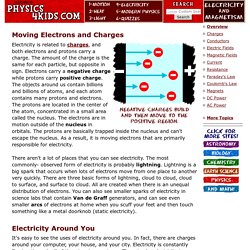

The Atoms Family. AMAZING Science Experiments With Magnets - Oddly Satisfying Video. How far would you have to go to escape gravity? - Rene Laufer. World’s Easiest DIY Electric Train. Magnetic Field. The mystery of the magnetic train. This past week, thanks to Laughing Squid and other sources, a lot of people watched and were amazed by this simple demonstration of electromagnetism in action.

It is billed as the “world’s simplest electric train,” and it is almost certainly the case. Using only a battery, some strong magnets and some (bare) coiled copper wire, one can make the “train” travel numerous circuits through the copper “track,” until the battery is completely drained. This caught my attention because it is a very clever twist on one of Michael Faraday’s original discoveries! Not electromagnetic induction, as I reflexively thought, but a homopolar motor. Below is an animation of such a motor that I whipped up in my office.
A simple homopolar motor. This particular homopolar motor design is ridiculously simple: a pair of neodymium magnets are stuck (by magnetic force only) to the bottom of an AA battery. Simple Electric Train. Simple Science Project with Physics Girl! Electromagnets - How Do They Work? Parts of an Atom. Earth's Magnetic Field - An Explanation. Magnets & Magnetism for kids. Electromagnetic Induction. Magnetic Field. Magnetism for Kids. Teacher Workshop: Make a Magnetic Field. The Science Behind Magnets: How do they Work? - Stuff to Blow Your Kids' Mind #2. MAGLEV train "capable" of 3,500 km/h. Earth's Magnetic Field 'simpler Than We Thought' Scientists have identified patterns in Earth's magnetic field that evolve on the order of 1,000 years, providing new insight into how the field works and adding a measure of predictability to changes in the field not previously known.

The discovery also will allow researchers to study the planet's past with finer resolution by using this geomagnetic "fingerprint" to compare sediment cores taken from the Atlantic and Pacific oceans. Results of the research, which was supported by the National Science Foundation, were recently published in Earth and Planetary Science Letters. The geomagnetic field is critical to life on Earth. Without it, charged particles from the sun (the "solar wind") would blow away the atmosphere, scientists say. The field also aids in human navigation and animal migrations in ways scientists are only beginning to understand. Yet in spite of its importance, many questions remain unanswered about why and how these changes occur. The science of static electricity - Anuradha Bhagwat.
You can see the effects of static electricity everywhere.

The effects of static electricity are seen when an insulating material such as plastic, rubber, or wool is involved. Which materials lose electrons readily depends on the inner structure of materials themselves and how tightly the electrons are bound. Physicists have ranked materials by the order in which they lose or gain electrons. This ranking is called the triboelectric series. And what is it with static electricity and human skin? At home and in factories, there are places where you will see thick metal wires connected physically to Earth – these are known as earthing wires or grounding wires. Why do we experience effects of static electricity mostly in dry, winter climates? For some experiments about static electricity that are simple to do go here! Electricity & Magnetism: Introduction. Electricity is related to charges, and both electrons and protons carry a charge.

The amount of the charge is the same for each particle, but opposite in sign. Electrons carry a negative charge while protons carry positive charge. The objects around us contain billions and billions of atoms, and each atom contains many protons and electrons. What is the magnetic field? MAGNETS: How Do They Work? Static Flyer - The Flying Bag. Who needs a magic wand to create levitating objects when you have a balloon?

Well, if you know how static electricity works, you won’t need a wand! In the Static Flyer experiment, we’ll teach you how understanding electrical charges can result in a trick that would make Harry Potter, Gandalf the Grey, and even Merlin jealous. SICK Science® is a registered trademark of Steve Spangler, Inc. All Rights Reserved. How Does It Work Rubbing the towel against the balloon and the plastic band transfers a negative charge to both objects. When you rub a balloon on someone’s hair the balloon picks up electrons, leaving it negatively charged and the hair positively charged. When you bring a charged balloon near pieces of paper, the paper isn’t charged so you might expect nothing to happen. Science Fair Connection Floating a plastic ring above a balloon is cool, but it isn’t a science fair project. Try using other objects to levitate the plastic band.
Charges And Fields 1.0.3